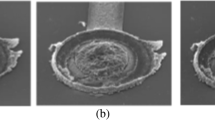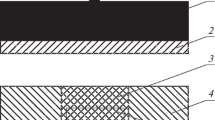Conclusions
-
1.
The mean jump of elongation δ0 in uniaxial plastic strain of a polycrystalline specimen is proportional to D2, where D is the mean dimension of the fragments (regions of ideal crystal lattice), therefore in consequence of fragmentation it decreases with increasing plastic strain e in accordance with the relation δ0∿e-1.
-
2.
The intensity of the signal of acoustic emission Wξ∿δ0∿e-1, and its rms value Uξ∿e-1/2, which is in agreement with the experimental data. This testifies to the fact that fragmentation is the main cause of the drop of the characteristics of AE of polycrystals beyond the yield point.
Similar content being viewed by others
Literature Cited
V. A. Greshnikov and Yu. B. Drobot, Acoustic Emission [in Russian], Standartov, Moscow (1976).
A. A. Yudin and V. I. Ivanov, “Acoustic emission in plastic deformation of metals (review),” Probl. Prochn., No. 6, 92–107, (1985).
P. Jax, Schallemission bei plastischer Verformung von Metallen, in: Schallemission: Anwendung bei Untersuchung, Prüfung and Überwachung metallischer Werkstoffe, Deutsche Gesellschaft für Metallkunde, Frankfurt am Main (1974), pp. 59–117.
J. Eisenblätter, P. Jax, and H. J. Schwalbe, A Survey of Acoustic Emission Research in Europe and Investigations Conducted at Battelle Frankfurt. Paper presented at the 2nd Acoustic Emission Symposium, 2–4 Sept. 1974, Tokyo, Battelle Institute E. V., Frankfurt.
R. B. Engle and H. L. Dunegan, “Acoustic emission: stress wave detection as a tool for nondestructive testing and material evaluation,” Int. J. Nondestr. Test.,1, No. 1, 109–125 (1969).
J. D. Hilman, “The microdynamic theory of plasticity,” in: Microplasticity, Metallurgiya, Moscow (1972), pp. 18–37.
V. E. Panin, V. A. Likhachev, and Yu. V. Grinyaev, Structural Levels of the Deformation of Solids [in Russian], Nauka, Novosibirsk (1985).
G. Sundararadjan, “The saturation of flow stress in fcc metals,” Scr. Met.,16, No. 5, 611–614 (1982).
E. S. Kayali and A. Plumtree, “Stress-substructure relationships in cyclically and monotonically deformed wavy slip mode metals,” Met. Trans. Phys. Met. Mater. Sci.,13A, No. 6, 1033–1041 (1982).
A. A. Yudin and V. I. Ivanov, “Correlation of the signal of acoustic emission with plastic deformation of metal,” Probl. Prochn., No. 6, 103–105 (1986).
V. A. Strizhalo, M. V. Kalashnik, S. I. Likhatskii, et al., “Investigation of the nature of the signals of acoustic emission in pure polycrystalline metals under static tension,” Probl. Prochn., No. 11, 17–21 (1983).
Additional information
Central Research Institute of Engineering Technology, Moscow. Translated from Problemy Prochnosti, No. 10, pp. 74–77, October, 1988.
Rights and permissions
About this article
Cite this article
Yudin, A.A., Ivanov, V.I. Cause of attenuation of signals of acoustic emission in plastic deformation of metals beyond the yield point. Strength Mater 20, 1362–1366 (1988). https://doi.org/10.1007/BF01531553
Received:
Issue Date:
DOI: https://doi.org/10.1007/BF01531553




